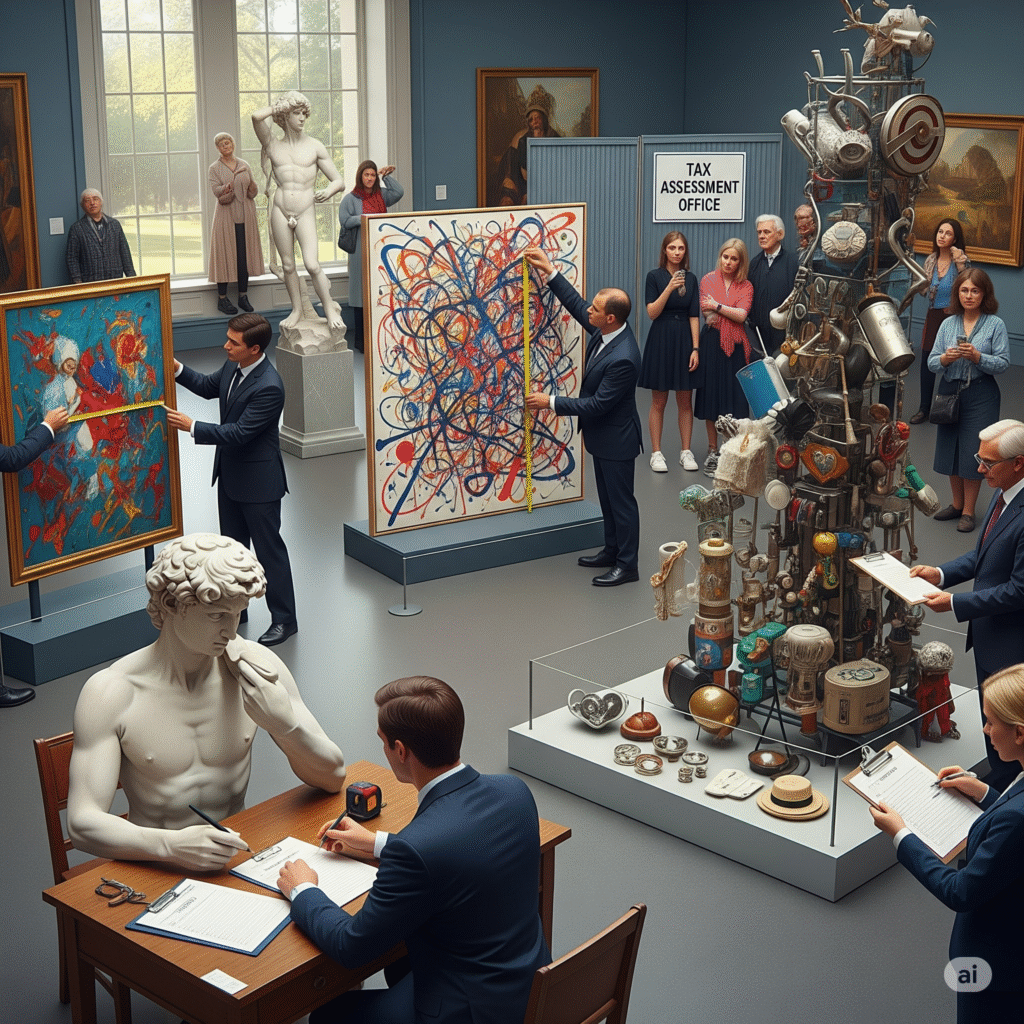Arun Kakar, Artsy’s Art Market Editor, provides a vital—though partial—diagnosis of the challenges posed by recent U.S. tariff policies on the global art trade in 2025. In his articles “What Art Collectors Need to Know About Trump’s Tariffs” (March 25, 2025), “Is Art Affected by Trump’s Tariffs?” (April 10, 2025), and “4 Ways Trump’s Tariffs Have Changed Art Collecting in 2025” (August 7, 2025), Kakar precisely maps the immediate symptoms: fragile exemptions for artworks, rising logistical costs, and customs bureaucracy. However, a critical dialogue with his analysis reveals structural fissures in the international art market that go beyond specific governments, demanding deeper reflections on systemic strategies to build effective responses.
I. The Chimera of Legal Exemption: Between Text and Customs Practice
Kakar rightly highlights the formal exclusion of “works of art” from general tariffs under 50 USC §1702 (a U.S. national defense statute used to apply tariffs). Yet this apparent legal certainty clashes with a far more complex operational reality. Final determinations of what qualifies as “exempt art” rest with Customs and Border Protection (CBP) officers, often lacking expertise in artistic classification. Cases like the mother-of-pearl artwork blocked at the border—cited by Kakar—are not anomalies but symptoms of a system where hybrid materials (metals, wood, textiles) turn creations into “suspect objects.” Functional design, limited editions, and digital artworks remain caught in a regulatory grey zone. Kakar notes that the Harmonized Tariff Schedule (HTS) employs criteria such as “artistic intent” and “market recognition” to define exemptions; however, these open-ended parameters foster ongoing legal uncertainty. This subjectivity invites divergent readings by customs agents and opens space for inconsistent decisions, where a work’s fiscal fate may hinge more on individual perception than on objective standards. Moreover, the explicit exception for contemporary Chinese art mentioned in his third article exposes how exemptions can be suspended for geopolitical reasons, revealing their political rather than technical nature.
II. The Systemic Cost of New Bureaucracy: Forced Market Reengineering
While Kakar documents logistical delays and documentary complexity, his analysis underestimates how these factors reconfigure the sector’s economy. In Brazil, for example, the operational cost per shipment has doubled, forcing additional hires solely for customs management. This is not a circumstantial adjustment but a permanent restructuring of the business model for transnational galleries. The tariff impact unfolds as a domino effect reshaping the art market. Smaller galleries and emerging artists, lacking resources for specialized teams or extended storage, face severe restrictions in their ability to operate internationally. Simultaneously, logistics becomes a decisive factor, segmenting the market into local and global transactions, directly affecting liquidity and valuation. For this reason, collectors, as consultant Peter Bentley Brandt notes in Kakar’s work, adopt more strategic stances, favoring acquisitions already situated in jurisdictions deemed safe, thus reinforcing market inequality and power asymmetry. Furthermore, Tom Burns (Fortress Art Storage) encapsulates the bureaucratic strangulation with his remark on pre-customs paralysis: “Nothing ships until the paperwork is exactly right,” redefining deadlines and costs as structural variables.
III. Expanded Vulnerabilities: The Brazilian and Chinese Cases
The macroeconomic impact on peripheral economies illustrates how general trade policies indirectly paralyze art markets. In Brazil, tariffs of up to 50% on 35.9% of exports to the U.S.—including coffee, footwear, and textiles—are expected to reduce GDP by 0.4-0.5%, according to Goldman Sachs. The Port of Santos recorded a record volume in July (17 million tons) amid pre-tariff rushes, followed by massive cancellations. Considering the art market’s logistics, this volatility compromises the flow of specialized materials and undermines planning for international exhibitions. In China’s case, as previously noted, the issue transcends economics, reaching into politics and cultural exchange. With reciprocal tariffs of 125% between the U.S. and China, contemporary art circulation has nearly ceased. American participation in Chinese cultural institutions has drastically declined, signaling a cultural decoupling where soft power becomes collateral damage in trade wars.
IV. Strategic Responses for a New Era
Faced with this scenario, political and economic actions must address structural challenges. Regionalizing markets can strengthen local artistic ecosystems and reduce dependence on global centers under tariff strain. Brazil, for example, has sought to realign partnerships with China, BRICS, and Mercosur, fostering new exhibition circuits regionally. Simultaneously, technological revolutions in logistics offer paths to reduce cross-border frictions, with blockchain used for provenance tracking, artificial intelligence automating HTS classification, and immersive virtual exhibitions providing alternatives to physical transport. Moreover, collective advocacy is gaining momentum, as sector entities push for clear global definitions—expanding “works of art” to include digital media and contemporary practices, recognizing cultural exchange as a distinct category in trade agreements, and demanding explicit protections against geopolitical instrumentalization. Finally, building resilient supply chains through supplier diversification, local production incentives, and regional logistics hubs emerges as a fundamental strategy to mitigate disruption risks.
Conclusion: Beyond Crisis Management
Kakar’s articles succeed in revealing the immediate mechanisms of trade barriers, yet, as the cases of Brazil and China illustrate, the true landscape is marked by profound reconfiguration. Art no longer faces tariffs alone; it is undergoing an accelerated metamorphosis into a regulated luxury commodity, subject to geopolitical asymmetries and systemic disruptions. While the passion for collecting has become more “refined,” as Brandt suggests, based on Kakar’s observations, its democratic reach is narrowing. The strategic challenge ahead is not merely to weather a passing storm but to reinvent the vessel itself to navigate a sea of permanent turbulence. Along this journey, a steadfast defense of art’s cultural value—beyond its market price—becomes indispensable.

